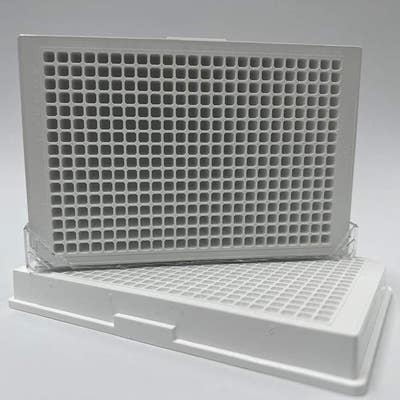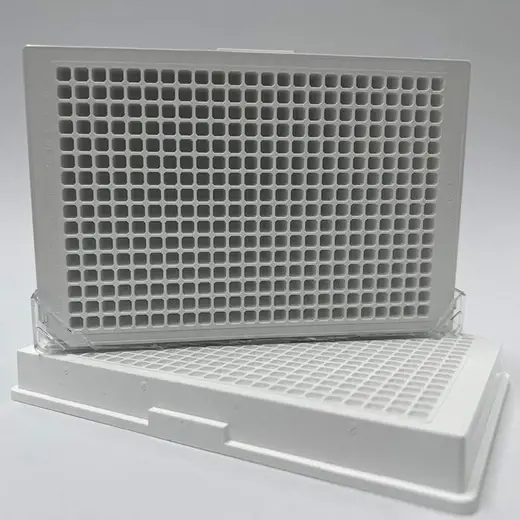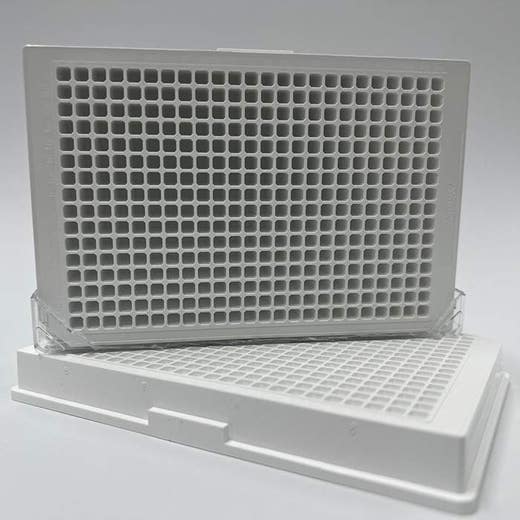
OptiPlate 384-well, white opaque, case of 50

OptiPlate 384-well, white opaque, case of 50




384-well microplate for use in time-resolved fluorescence, luminescence, Alpha, and radiometric assays. This OptiPlate™ is white and made of polystyrene.
| Feature | Specification |
|---|---|
| Surface Treatment | Untreated |
| Color | White |
| Detection Modality |
Alpha Luminescence Radiometric Time-Resolved Fluorescence (TRF & TR-FRET) |
| Lids Included? | No |
| Material | Polystyrene |
| Sterility | Non-Sterile |
| Plate Format | 384 wells |
| Well Shape | Flat-bottom |
| Well Volume | 105 µL |
| Working Volume | 24 - 90 µL |
384-well microplate for use in time-resolved fluorescence, luminescence, Alpha, and radiometric assays. This OptiPlate™ is white and made of polystyrene.


OptiPlate 384-well, white opaque, case of 50


OptiPlate 384-well, white opaque, case of 50


Product information
Overview
OptiPlate™ is one of most versatile microplates offered by Revvity, used in many different applications, assays, and instruments. optimized well design and high quality plastics provides low background and crosstalk.
OptiPlates are uniquely engineered to be same height 96-, 384-, and 1536-well plates, and with extraordinary well flatness ease in automation.
Leveraging years of assay and instrument experience in plate detection, Revvity designs better microplates better performance that guarantees better results all Revvity applications.
Packaging notes:
- Cases of 50 are packaged as 2 sleeves of 25 plates each. Each sleeve as 5 wraps with 5 plates.
- Cases of 100 are packaged as 4 sleeves of 25 plates each.
- Cases of 200 are packaged as 8 sleeves of 25 plates each. Each sleeve as 5 wraps with 5 plates.
Well plate dimensions
Well format: 384-well
| Description | Specification |
|---|---|
| Number of rows | 16 |
| Number of columns | 24 |
| Well volume | 105 µL |
| Recommended working volume | 24 µL – 90 µL |
| Height (mm) | 14.35 |
| Length (mm) | 127.76 |
| Width (mm) | 85.47 |
| Well diameter (mm) | 3.65 |
| Well depth (mm) | 10.4 |
| A1 to top offset (mm) | 9 |
| A1 to side offset (mm) | 12.1 |
| Well-to-well spacing (mm) | 4.5 |
Specifications
| Color |
White
|
|---|---|
| Plate Format |
384 wells
|
| Well Shape |
Flat-bottom
|
| Well Volume |
105 µL
|
| Working Volume |
24 - 90 µL
|
| Application |
Radiometric
Research
|
|---|---|
| Automation Compatible |
Yes
|
| Brand |
OptiPlate
|
| Detection Modality |
Alpha
Luminescence
Radiometric
Time-Resolved Fluorescence (TRF & TR-FRET)
|
| Format |
Microplates
|
| Lids Included? |
No
|
| Material |
Polystyrene
|
| Shipping Conditions |
Shipped Ambient
|
| Sterility |
Non-Sterile
|
| Surface Treatment |
Untreated
|
| Unit Size |
Case of 50
|
Resources
Are you looking for resources, click on the resource type to explore further.
Electrophoretic Mobility Shift Assay (EMSA) is a standard technique used to study protein-DNA interactions. It is a radioactive...
Leptospirosis is an infectious disease caused by Leptospira bacteria, which can spread across different species of mammals...
AlphaLISA™ technology is a highly sensitive, easy-to-use, and reproducible method for detecting and quantifying molecules in...
Fc Gamma Receptors (FcγRs) are critical for the function of therapeutic antibodies and mediate many effector functions.
Therapeutic...
The measurement of protein phosphorylation is a useful tool for measuring the modulation of receptor activation by both antibodies...
AlphaLISA and LANCE (TR-FRET) biomarker assays can be used to measure ECM-associated protein modulation caused by human...


How can we help you?
We are here to answer your questions.






























